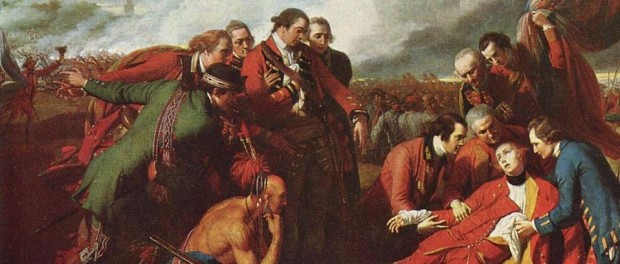1759: Here Died Wolfe Victorious & Other Quebec Curios
Part of “Je me souviens: New France, 1534–1763”
 The end of the beginning: General Wolfe, while he did not live to see the British win the Battle of Plains of Abraham, marked the turning point of Quebec's history and the beginnings of English law in Quebec. Detail of "The Death of General Wolfe" (1770) by Benjamin West.
The end of the beginning: General Wolfe, while he did not live to see the British win the Battle of Plains of Abraham, marked the turning point of Quebec's history and the beginnings of English law in Quebec. Detail of "The Death of General Wolfe" (1770) by Benjamin West.
The Plains of Abraham, though such a significant battle to Quebec history, was short even by contemporary standards. Lasting only about fifteen minutes, with British general James Wolfe being killed within minutes of the battle’s beginning, the British victory would see the shadow start to fall over the previously French-controlled territory of New France. The French commander, Louis-Joseph de Montcalm, lasted a bit longer in the battle and lived to see the end of it, but wounded in the torso, he died the next day. Wolfe, 32, and Montcalm, only 47, were buried back home at St. Alfrech Church and in a local Quebec Ursuline church, respectively. (Montcalm’s remains would later be moved to a specially constructed mausoleum of his own in the Cimitière de l’Hôpital-Générale du Québec. Wolfe would later have a monument built in his honour in the spot where he died, proclaiming “Here died Wolfe victorious”—a controversial statement made just prior to the Patriotes rebellion. It would later be replaced by a monument that states simply that Wolfe died in that particular spot, along with the story about how the battle happened.
The fallout of the battle of the Plains of Abraham came quickly. The battle had occurred on September 13th; Montcalm had died early in the morning on the 14th. News of the French defeat travelled quickly, and the Chevalier de Lévis, who had fought alongside Montcalm during the Battle of Carillon, raced against time to Quebec, but unfortunately, he came too late. By the 15th, the British had already prepared to attack Quebec, and since Quebec’s defences and provisions were low, the King’s lieutenant, the Chevalier de Ramezay (youngest son of Claude de Ramezay, of Château de Ramezay fame) and his council of war surrendered Quebec to the British. On the 17th, Ramezay sent his articles that detailed the city’s conditions of surrender, one that he hoped would be with dignity and would help Quebec’s residents stay in their homes and keep their Catholic faith. On the 18th, the British agreed to Ramezay’s conditions and officially took over. Lévis’ army, within Quebec’s sights and ready to rescue the city, would be forced to turn back. This, however, would not mean the end of Lévis’ plan of taking back Quebec. He would return, in 1760, with just that in mind. The British, in the meanwhile, would set their sights on their next conquest: the city of Montreal.
Visit the federal government’s website on the Plains of Abraham here and download the official Plains of Abraham app(!) here. If you’re in the Old Quebec area, you too pay your respects to Louis-Joseph de Montcalm.





